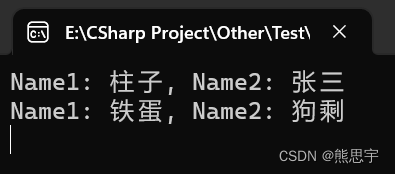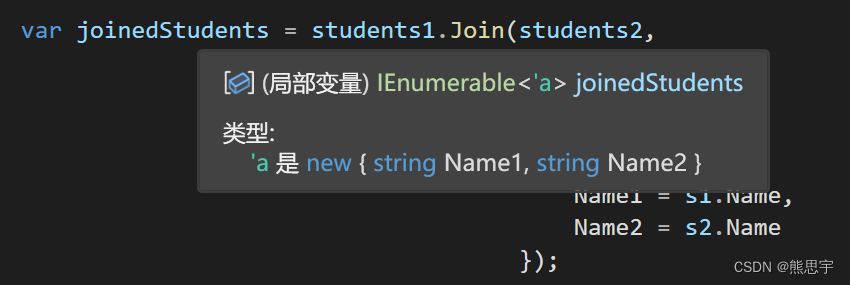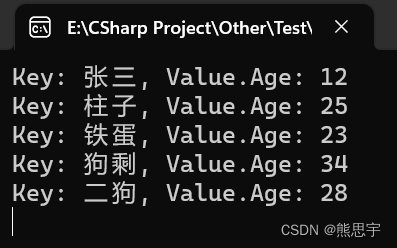目录
C# Linq 详解一
1.Where
2.Select
3.GroupBy
4.First / FirstOrDefault
5.Last / LastOrDefault
C# Linq 详解二
1.OrderBy
2.OrderByDescending
3.Skip
4.Take
5.Any
6.All
C# Linq 详解三
1.Sum / Min / Max / Average
2.Distinct
3.Concat
4.Join
5.ToList
6.ToArray
7.ToDictionary
C# Linq 详解四
1.SelectMany
2.Aggregate
3.DistinctBy
4.Reverse
5.SequenceEqual
6.Zip
7.SkipWhile
8.TakeWhile
概述
语言集成查询 (LINQ) 是一系列直接将查询功能集成到 C# 语言的技术统称。 数据查询历来都表示为简单的字符串,没有编译时类型检查或 IntelliSense 支持。 此外,需要针对每种类型的数据源了解不同的查询语言:SQL 数据库、XML 文档、各种 Web 服务等。 借助 LINQ,查询成为了最高级的语言构造,就像类、方法和事件一样。
对于编写查询的开发者来说,LINQ 最明显的“语言集成”部分就是查询表达式。 查询表达式采用声明性查询语法编写而成。 使用查询语法,可以用最少的代码对数据源执行筛选、排序和分组操作。 可使用相同的基本查询表达式模式来查询和转换 SQL 数据库、ADO .NET 数据集、XML 文档和流以及 .NET 集合中的数据。
十三、Sum / Min / Max / Average
计算序列中指定属性的总和、最小值、最大值、平均值。
using System;
using System.Collections.Generic;
using System.Linq;
namespace LinqTest
{
internal class Program
{
static void Main(string[] args)
{
List<int> numList = new List<int> { 1, 4, 5, 24, 43, 67, 12, 90, 15 };
int sum = numList.Sum();
Console.WriteLine("总和:{0}", sum);
int min = numList.Min();
Console.WriteLine("最小值:{0}", min);
int max = numList.Max();
Console.WriteLine("最大值:{0}", max);
double average = numList.Average();
Console.WriteLine("平均值:{0}", average);
Console.ReadKey();
}
}
}运行:

十四、Distinct
Distinct 方法用于从集合中筛选出不重复的元素。它返回一个新的集合,其中包含原始集合中的唯一元素。
using System;
using System.Collections.Generic;
using System.Linq;
namespace LinqTest
{
internal class Program
{
static void Main(string[] args)
{
int[] numList = { 1, 2, 2, 3, 3, 4, 5, 5 };
var distinctNumbers = numList.Distinct();
foreach (var number in distinctNumbers)
{
Console.WriteLine(number);
}
Console.ReadKey();
}
}
}运行:

十五、Concat
Concat 方法用于将两个集合合并为一个新的集合。当前方法没有重载函数,通常用在将数组分类后,挑出需要的集合,合并后重新处理。
using System;
using System.Collections.Generic;
using System.Linq;
namespace LinqTest
{
internal class Program
{
static void Main(string[] args)
{
int[] numbers1 = { 1, 2, 3 };
int[] numbers2 = { 4, 5, 6 };
var mergedNumbers = numbers1.Concat(numbers2);
foreach (var number in mergedNumbers)
{
Console.WriteLine(number);
}
Console.ReadKey();
}
}
}运行:

十六、Join
根据两个序列中的关联键,将它们的元素进行匹配。
Join 的用法,在 Linq 中算是比较复杂的了,用起来变化也比较多,这里用一个简单的例子,推荐各位多写多练,多写一些案例,用多了就比较熟了
using System;
using System.Collections.Generic;
using System.Linq;
namespace LinqTest
{
internal class Program
{
static void Main(string[] args)
{
List<Student> students1 = new List<Student>
{
new Student { Id = 1, Name = "柱子" },
new Student { Id = 2, Name = "李四" },
new Student { Id = 3, Name = "铁蛋" }
};
List<Student> students2 = new List<Student>
{
new Student { Id = 1, Name = "张三" },
new Student { Id = 3, Name = "狗剩" },
new Student { Id = 5, Name = "二狗" }
};
var joinedStudents = students1.Join(students2,
s1 => s1.Id,
s2 => s2.Id,
(s1, s2) => new
{
Name1 = s1.Name,
Name2 = s2.Name
});
foreach (var student in joinedStudents)
{
Console.WriteLine($"Name1: {student.Name1}, Name2: {student.Name2}");
}
Console.ReadKey();
}
}
class Student
{
public int Id { get; set; }
public string Name { get; set; }
}
}运行:

在上面 Join 的代码中,首先看下面这两句代码,这里是在两个 List 中,找出一个共同的键,比如 s1 和 s2 都有一个共同的键 Id,这里会判断 Id 的值在两个 List 中是否有相同的值,它查询的结果同样是个集合,在上面代码可以看到,Id 有两个共同的值,1 和 3。
s1 => s1.Id,
s2 => s2.Id,下面代码是一个 Lambda 表达式,它将 s1 和 s2 作为参数传递到了一个新的对象中,Name1 和 Name2 都是自己定义的字段名,这里可以随意取名字
(s1, s2) => new
{
Name1 = s1.Name,
Name2 = s2.Name
});比如,取名成这样,也是不会报错的

找出相同字段的集合后,就可以在这个 Lambda 表达式里重新筛选数据了,我们把鼠标放到 joinedStudents 这里,可以看到是一个叫 'a 的类,这就是上面我们自定义的类

十七、ToList
将序列转换为List
在上面的很多案例都可以将查询的结果转换为 List,下面来看一个案例,非常简单
using System;
using System.Collections.Generic;
using System.Linq;
namespace LinqTest
{
internal class Program
{
static void Main(string[] args)
{
List<int> numList = new List<int> { 1, 4, 5, 24, 43, 67, 12, 90, 15 };
List<int> list = numList.Where(x => x > 40).ToList();
foreach (int num in list)
{
Console.WriteLine(num);
}
Console.ReadKey();
}
}
}运行:

十八、ToArray
将序列转换为Array
ToArray 和 ToList 用法差不多的,只是转换的结果不一样
using System;
using System.Collections.Generic;
using System.Linq;
namespace LinqTest
{
internal class Program
{
static void Main(string[] args)
{
List<int> numList = new List<int> { 1, 4, 5, 24, 43, 67, 12, 90, 15 };
int[] ints = numList.Where(x => x > 40).ToArray();
foreach (int num in ints)
{
Console.WriteLine(num);
}
Console.ReadKey();
}
}
}运行:

十九、ToDictionary
根据指定的键选择器,将序列转换为字典。
using System;
using System.Collections.Generic;
using System.Linq;
namespace LinqTest
{
internal class Program
{
static void Main(string[] args)
{
List<People> peopleList = new List<People>()
{
new People(){Name="张三", Age=12, Career="学生" },
new People(){Name="柱子", Age=25, Career="农民" },
new People(){Name="铁蛋", Age=23, Career="农民" },
new People(){Name="狗剩", Age=34, Career="职员" },
new People(){Name="二狗", Age=28, Career="职员" },
};
Dictionary<string, People> peopleDictionary = peopleList.ToDictionary(x => x.Name);
foreach (var kvp in peopleDictionary)
{
Console.WriteLine($"Key: {kvp.Key}, Value.Age: {kvp.Value.Age}");
}
Console.ReadKey();
}
}
class People
{
public string Name { get; set; }
public int Age { get; set; }
public string Career { get; set; }
}
}运行:

end